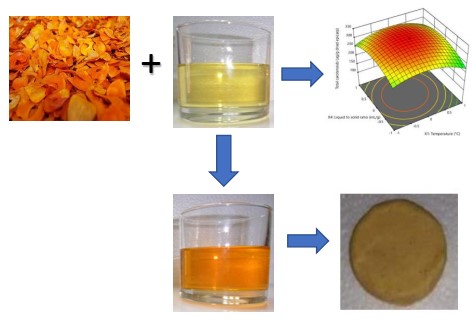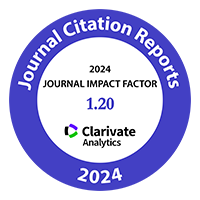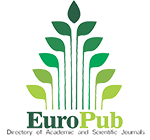Obtaining a lipid extract from peach palm (Bactris gasipaes Kunth) epicarp. Quantification of carotenoid content and application as a food additive
DOI:
https://doi.org/10.48162/rev.39.163Palabras clave:
Bactris gasipaes, B-caroteno, agroindustria de maíz, colorante natural, extracción asistida por homogeneizaciónResumen

The agro-industrial assessment of fruit by-products as food additives would allow compliance with Sustainable Development Goals. This research aimed at the homogenizer-assisted extraction of total carotenoids from peach palm (Bactris gasipaes) peel (epicarp) with sunflower oil. We also studied its application as a natural additive in white corn flour food. The response surface methodology and the rotational composite central design quantified the extraction process. The studied factors were extraction speed, temperature, time, and liquid-solid ratio. Total carotenoid content in the extract (336.06 µg/g dried epicarp) was optimized at 50°C, with 76 seconds, extraction speed of 19200 rpm, and liquid-solid ratio of 48.75 mL/g. The green extract obtained from homogenizer-assisted extraction constitutes a natural additive with agro-industrial potential for use in roasted corn cake, increasing carotenoid (30.60 µg/g of β-carotene), provitamin A (4.14 µg/g) and antioxidant activity (11.57 % DPPH).
Highlights:
- Homogenizer-assisted extraction (HAE) is adequate for carotenoid extraction in peach palm epicarp.
- The lipid extract from the peach palm epicarp is a source of provitamin A.
- Lipid extract obtained is a natural additive with potential for use in corn griddle cakes.
Descargas
Citas
Baria, B.; Upadhyay, N.; Singh, A. K.; Malhotra, R. K. 2019. Optimization of green extraction of carotenoids from mango pulp using split plot design and its characterization. LWT. 104: 186-194. doi.org/10.1016/j.lwt.2019.01.044
Bilgin, M.; Elhussein, E. A. A.; Özyürek, M.; Güçlü, K.; Şahin, S. 2018. Optimizing the extraction of polyphenols from Sideritis montana L. using response surface methodology. Journal of Pharmaceutical and Biomedical Analysis. 158: 137-143. doi.org/10.1016/j. jpba.2018.05.039
Dall’Acqua, S.; Kumar, G.; Sinan, K. I.; Sut, S.; Ferrarese, I.; Mahomoodally, M. F.; Zengin, G. 2020. An insight into Cochlospermum planchonii extracts obtained by traditional and green extraction methods: Relation between chemical compositions and biological properties by multivariate analysis. Industrial Crops and Products. 147: 112226. doi.org/10.1016/j. indcrop.2020.112226
da Silva Lima, R.; Nunes, I. L.; Block, J. M. 2020. Ultrasound-assisted extraction for the recovery of carotenoids from Guava’s pulp and waste powders. Plant Foods for Human Nutrition. 75(1): 63-69. doi.org/10.1007/s11130-019-00784-0
de Souza Mesquita, L. M.; Neves, B. V.; Pisani, L. P.; de Rosso, V. V. 2020. Mayonnaise as a model food for improving the bioaccessibility of carotenoids from Bactris gasipaes fruits. LWT. 122: 109022. doi.org/10.1016/j.lwt.2020.109022
Eyiz, V.; Tontul, I.; Turker, S. 2020. Optimization of green extraction of phytochemicals from red grape pomace by homogenizer assisted extraction. Journal of Food Measurement and Characterization. 14(1):39-47. doi.org/10.1007/s11694-019-00265-7
Khalid, M.; Rahman, S. U.; Bilal, M.; Iqbal, H. M. N.; Huang, D. 2019. Biosynthesis and biomedical perspectives of carotenoids with special reference to human health related applications. Biocatalysis and Agricultural Biotechnology. 17: 399-407. doi.org/10.1016/j. bcab.2018.11.027
Kramer, Y. V.; Clement, C. R.; de Carvalho, J. C.; Fernandes, A. V.; da Silva, C. V. A.; Koolen, H. H. F.; Aguiar, J. P. L.; Nunes-Nesi, A.; Ramos, M. V.; Araújo, W. L.; de Carvalho Gonçalves, J. F. 2023. Understanding the technical-scientific gaps of underutilized tropical species: The case of Bactris gasipaes Kunth. Plants. 12(2): 337. doi.org/10.3390/plants12020337
López, A.; Montaño, A.; Garrido, A. 2005. Provitamin A carotenoids in table olives according to processing styles, cultivars, and commercial presentations. European Food Research and Technology. 221(3): 406-411. doi.org/10.1007/s00217-005-1190-8
Martínez-Girón, J.; Ordoñez-Santos, L. E.; Rodríguez-Rodríguez, D. X. 2019. Extraction of total carotenoids from peach palm fruit (Bactris gasipaes) peel by means of ultrasound application and vegetable oil. DYNA. 86(209): 91-96. doi.org/10.15446/dyna.v85n207.74840
Martínez-Girón, J.; Osorio, C.; Ordoñez-Santos, L. E. 2022. Effect of temperature and particle size on physicochemical and techno-functional properties of peach palm peel flour (Bactris gasipaes, red and yellow ecotypes). Food Science and Technology International. 28(6): 535-544. doi.org/10.1177/10820132211025133
Matos, K. A. N.; Lima, D. P.; Barbosa, A. P. P.; Mercadante, A. Z.; Chisté, R. C. 2019. Peels of tucumã (Astrocaryum vulgare) and peach palm (Bactris gasipaes) are by-products classified as very high carotenoid sources. Food Chemistry. 272: 216-221. doi.org/10.1016/j. foodchem.2018.08.053
Menezes Silva, J. V.; Silva Santos, A.; Araujo Pereira, G.; Campos Chisté, R. 2023. Ultrasound-assisted extraction using ethanol efficiently extracted carotenoids from peels of peach palm fruits (Bactris gasipaes Kunth) without altering qualitative carotenoid profile. Heliyon. 9: 14933. doi.org/10.1016/j.heliyon.2023.e14933
Namitha, K. K.; Negi, P. S. 2010. Chemistry and biotechnology of carotenoids. Critical Reviews in Food Science and Nutrition. 50(8): 728-760. doi: 10.1080/10408398.2010.499811
Ordoñez-Santos, L. E.; Pinzón-Zarate, L. X.; González-Salcedo, L. O. 2015. Optimization of ultrasonic-assisted extraction of total carotenoids from peach palm fruit (Bactris gasipaes) by-products with sunflower oil using response surface methodology. Ultrasonics Sonochemistry. 27: 560-566. doi.org/10.1016/j.ultsonch.2015.04.010
Ordoñez-Santos, L. E.; Garzón-García, A. M. 2021a. Optimizing homogenizer-assisted extraction of chlorophylls from plantain epicarp (Musa paradisiaca L). Journal of Food Measurement and Characterization. 5: 1108-1115. doi.org/10.1007/s11694-020-00703-x
Ordóñez-Santos, L. E.; Esparza-Estrada, J.; Vanegas-Mahecha, P. 2021b. Ultrasound-assisted extraction of total carotenoids from mandarin epicarp and application as natural colorant in bakery products. LWT. 139: 110598. doi.org/10.1016/j.lwt.2020.110598
Pereira, G. A.; Arruda, H. S.; Molina, G.; Pastore, G. M. 2018. Extraction optimization and profile analysis of oligosaccharides in banana pulp and peel. Journal of Food Processing and Preservation. 42(1): 13408. doi.org/10.1111/jfpp.13408
Pinzón-Zárate, L. X.; Hleap-Zapata, J. I.; Ordóñez-Santos, L. E. 2015. Análisis de los parámetros de color en salchichas Frankfurt adicionadas con extracto oleoso de residuos de chontaduro (Bactris gasipaes). Información Tecnológica. 26(5): 45-54. doi.org/10.4067/S0718- 07642015000500007
Stinco, C. M.; Fernández-Vázquez, R.; Escudero-Gilete, M. A.; Heredia, F. J.; Meléndez-Martínez, A. J.; Vicario, I. M. 2012. Effect of orange juice’s processing on the color, particle size, and bioaccessibility of carotenoids. Journal of Agricultural and Food Chemistry. 60(6): 1447-1455. doi: 10.1021/jf2043949
Strati, I. F.; Oreopoulou, V. 2014. Recovery of carotenoids from tomato processing by-products-a review. Food Research International. 65: 311-321. doi.org/10.1016/J. FOODRES.2014.09.032
Suo, A.; Fan, G.; Wu, C., Li, T.; Cong, K. 2023. Green extraction of carotenoids from apricot flesh by ultrasound assisted corn oil extraction: Optimization, identification, and application. Food Chemistry. 420: 136096. doi.org/10.1016/j.foodchem.2023.136096
Tao, Y.; Sun, D. W. 2015. Enhancement of food processes by ultrasound: a review. Critical Reviews in Food Science and Nutrition. 55(4): 570-594. doi.org/10.1080/10408398.2012.667849
Tiwari, S.; Upadhyay, N.; Singh, A. K.; Meena, G. S.; Arora, S. 2019. Organic solvent-free extraction of carotenoids from carrot bio-waste and its physico-chemical properties. Journal of Food Science and Technology. 56(10): 4678-4687. doi.org/10.1007/ s13197-019-03920-5
Trigo, J. P.; Alexandre, E. M.; Saraiva, J. A.; Pintado, M. E. 2020. High value-added compounds from fruit and vegetable by-products - Characterization, bioactivities, and application in the development of novel food products. Critical Reviews in Food Science and Nutrition. 60(8): 1388-1416. doi.org/10.1080/10408398.2019.1572588
Turkmen, N.; Sari, F.; Velioglu, Y. 2005. The effect of cooking methods on total phenolics and antioxidant activity of selected green vegetables. Food Chemistry. 93(4): 713-718. doi. org/10.1016/j.foodchem.2004.12.038
Uekert, T.; Dorchies, F.; Pichler, C. M.; Reisner, E. 2020. Photoreforming of food waste into value-added products over visible-light-absorbing catalysts. Green Chemistry. 22(10): 3262-3271. doi. org/10.1039/D0GC01240H
Wong, W. H.; Lee, W. X.; Ramanan, R. N.; Tee, L. H.; Kong, K. W.; Galanakis, C. M.; Prasad, K. N. 2015. Two level half factorial design for the extraction of phenolics, flavonoids and antioxidants recovery from palm kernel by-product. Industrial Crops and Products. 63: 238-248. doi. org/10.1016/J.INDCROP.2014.09.049
Xu, Y.; Pan, S. 2013. Effects of various factors of ultrasonic treatment on the extraction yield of all-trans-lycopene from red grapefruit (Citrus paradise Macf.). Ultrasonics Sonochemistry. 20(4): 1026-1032. doi.org/10.1016/j.ultsonch.2013.01.006

Descargas
Publicado
Cómo citar
Número
Sección
Licencia
Derechos de autor 2018 Revista de la Facultad de Ciencias Agrarias UNCuyo

Esta obra está bajo una licencia internacional Creative Commons Reconocimiento-NoComercial-CompartirIgual 3.0.
Aquellos autores/as que tengan publicaciones con esta revista, aceptan las Políticas Editoriales.












.jpg)




